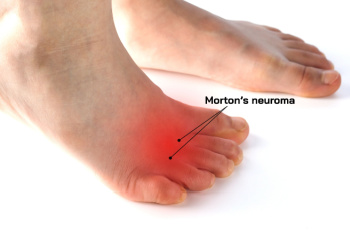
Morton's neuroma is a painful condition involving a thickened or irritated nerve in the ball of the foot, often between the third and fourth toes. It typically results from prolonged pressure or squeezing of the toes, often from wearing tight or high-heeled shoes. Symptoms of Morton’s neuroma include a burning sensation, sharp pain, or the feeling of a lump in the affected area, which worsens with walking or standing. A chiropodist can diagnose this condition through a physical examination and may recommend imaging tests like X-rays or ultrasounds. Treatment focuses on reducing pressure on the nerve, which includes wearing wider shoes and using custom shoe orthotics. If you have foot pain in the ball of the foot, it is suggested that you schedule an appointment with a chiropodist for a diagnosis and treatment.
Morton's neuroma can be highly uncomfortable. If you are experiencing the symptoms of Morton's neuroma, please consult with Cynthia Chan, B.Sc., D.Ch from Healthy Advantage Foot & Orthotic Clinic. Our practitioner will assess your condition and provide you with quality foot and ankle treatment.
What Is a Morton’s Neuroma?
Morton’s neuroma is a condition in which a nerve located in the ball of the foot between the third and fourth toes thickens due to compression or irritation. Common causes of Morton’s neuroma include wearing shoes with high heels or narrow toe boxes, participating in running or court sports, an injury or trauma to the area, or pressure being placed on the nerve from foot deformities such as bunions or hammertoes. Left untreated, Morton's neuroma may result in permanent nerve damage.
Symptoms
Symptoms of Morton’s neuroma often start gradually and worsen over time. Typical symptoms include:
- Foot pain
- Tingling, burning, or numbness in the affected foot
- The unique sensation that something is inside the ball of the foot or that there is something stuck in your shoe while walking
Treatment
Non-surgical treatments for this condition may include padding or icing the affected foot, wearing an orthotic device, modifying activities or shoes to reduce pressure on the foot, and taking medications or getting injections to reduce pain and inflammation. Surgery may be needed if non-surgical treatments are ineffective.
If you have any questions, please feel free to contact our office located in . We offer the newest diagnostic and treatment technologies for all your foot care needs.